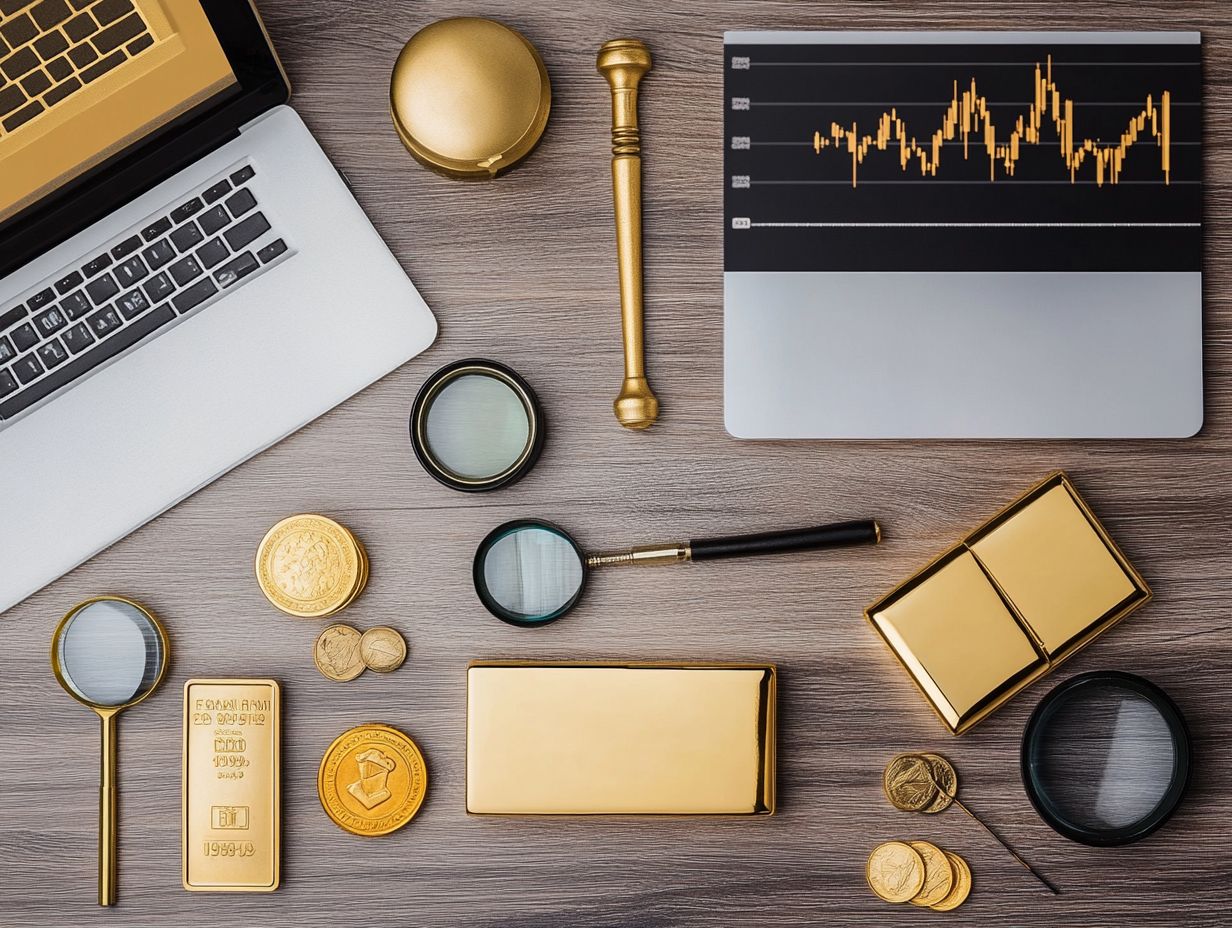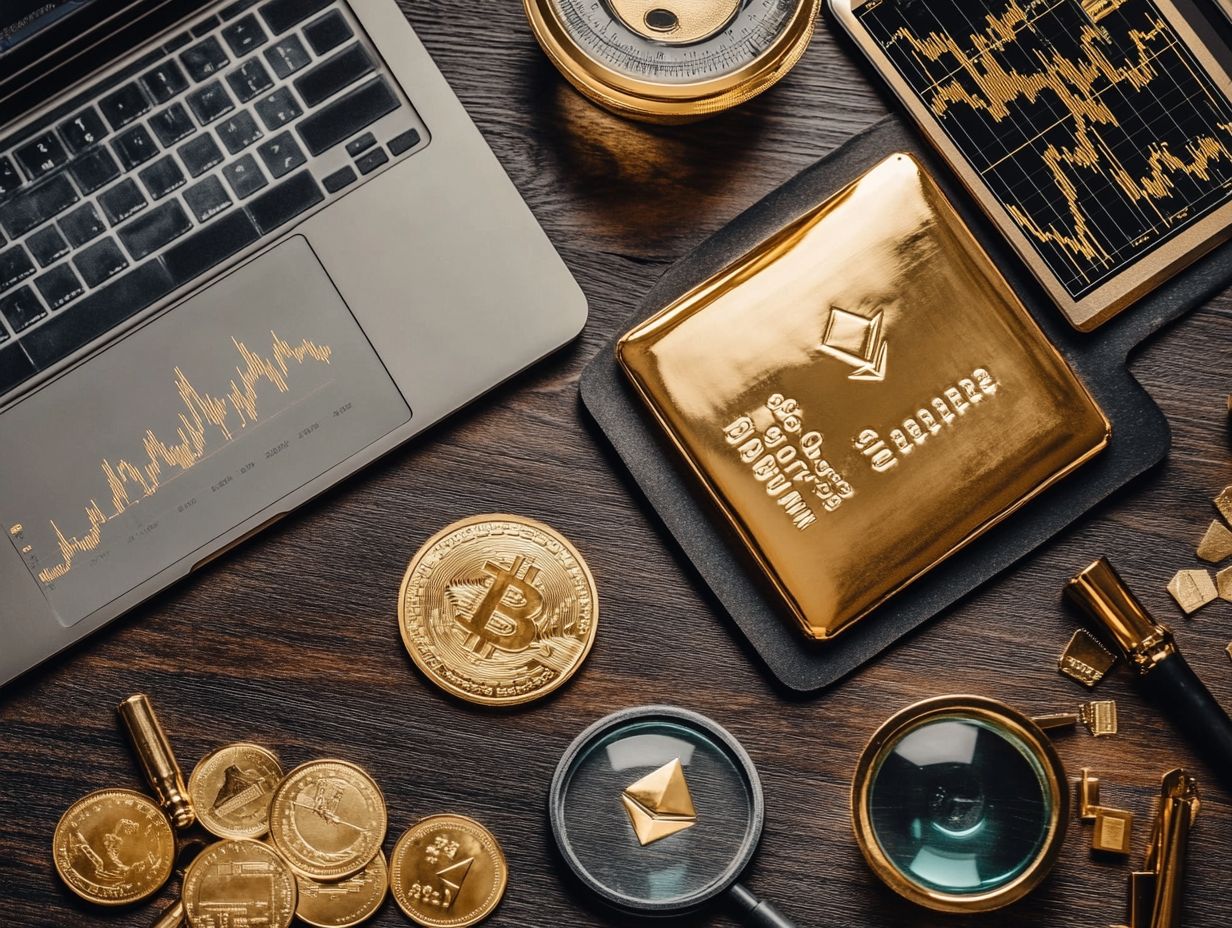5 Gold Investment Tools You Should Use
Investing in gold has long been regarded as a secure refuge for those seeking stability in an unpredictable market.
With a range of options available, from gold Exchange-Traded Funds (ETFs) to gold bullion, navigating these choices can seem daunting. This article delves into five essential gold investment tools, showcasing their unique benefits and potential risks.
It also provides guidance on selecting the right investment strategy and highlights common pitfalls to avoid. Whether you re a seasoned investor or just starting your journey, this guide offers valuable insights to elevate your investment experience.
Contents
- Key Takeaways:
- 1. Gold Exchange-Traded Funds (ETFs)
- 2. Gold Futures Contracts
- 3. Gold Mining Stocks
- 4. Gold Bullion
- 5. Gold Options
- What Are the Benefits of Investing in Gold?
- Frequently Asked Questions
- What are the 5 gold investment tools that are recommended for use?
- Why should I consider using these 5 gold investment tools?
- How do I invest in gold bullion?
- What are the benefits of investing in gold coins?
- What are gold ETFs and how do they differ from physical gold?
- Can anyone invest in gold mining stocks and gold futures?
Key Takeaways:
- Start investing in gold using ETFs, futures contracts, mining stocks, bullion (gold bars or coins), and options.
- Know the benefits and risks of each gold investment before you decide.
- Avoid common mistakes by considering price, market trends, and your financial goals.
1. Gold Exchange-Traded Funds (ETFs)
Gold Exchange-Traded Funds (ETFs) are funds that track gold prices and can be bought or sold like stocks, making them a compelling investment avenue for anyone interested in gold. They offer a perfect blend of liquidity and the convenience of online trading, appealing to a diverse range of investors who prioritize safety in investments and diversification in their portfolios.
These funds track the price of gold bullion, allowing you to tap into gold markets without the hassle of storing or insuring physical gold. One standout benefit of investing in gold ETFs is their typically lower management fees compared to mutual funds or actively managed portfolios. They provide easy entry and exit points through stock exchanges while maintaining a strong correlation with gold prices and responding swiftly to market trends.
Well-known gold ETFs like SPDR Gold Shares and iShares Gold Trust are celebrated for their transparency and reliability, making them an attractive choice for anyone looking to incorporate gold’s value into their investment strategy.
2. Gold Futures Contracts
Gold futures contracts offer a unique investment strategy, allowing you to speculate on gold prices while hedging against market fluctuations. This presents a dual opportunity for risk management and potential investment returns.
When you enter into these contracts, you commit to buying, and the seller commits to delivering, a specific quantity of gold at a predetermined price on a designated future date. This arrangement enables you to trade without the burdensome necessity of physically owning the asset, making it a cost-effective pathway into the gold market.
Utilizing gold futures enables you to shield your portfolio from adverse price movements, especially during economic downturns when precious metals often act as a safe haven. However, it s crucial to acknowledge that these instruments carry inherent risks, including market volatility and the potential for leveraged losses. Careful consideration of these risks is essential as you navigate your financial strategies.
3. Gold Mining Stocks
Investing in gold mining stocks presents an incredible chance to tap into the gold market while harnessing the inherent value of mining companies. You can potentially reap substantial returns tied to the appreciation of gold prices.
These stocks generally move in tandem with gold prices, so as the value of gold climbs, the profitability and stock prices of mining companies typically rise as well. This relationship is shaped by gold prices as well as factors like operational efficiencies, geopolitical risks, and production costs.
Leading companies in this field, such as Barrick Gold and Newmont Corporation, leverage their scale and established operations to capitalize on market dynamics. Trends like inflation and currency fluctuations can profoundly impact gold prices, which subsequently influences the overall performance of mining stocks, creating a vibrant landscape for savvy investors.
4. Gold Bullion

Gold bullion is a traditional and secure way to invest in physical gold. It offers you a tangible asset that safeguards against inflation and provides financial security, even with fluctuating gold prices.
Investing in bullion means acquiring actual bars or coins. This physical aspect provides comfort, contrasting with the volatility of paper assets.
However, it’s crucial to weigh the benefits against the drawbacks. Consider storage costs and liquidity, as selling bullion usually requires finding a reputable dealer, which can be challenging during high demand.
5. Gold Options
Gold options present you with a compelling opportunity to boost your investment power. They allow you to gain exposure to the gold market while strategically managing risk through calculated trading positions.
These contracts allow you to buy or sell the right to trade gold at a set price on or before a specified date. Call options help you capitalize on rising gold prices, while put options offer a safety net against potential declines.
By utilizing these options, you can significantly enhance your risk management strategies. This ensures you re well-prepared to weather market volatility without facing substantial losses.
Trading platforms are essential in this process, providing you with vital tools, real-time data, and a secure environment to make informed investment decisions efficiently.
Now that you understand gold options, let s explore the benefits of investing in gold.
What Are the Benefits of Investing in Gold?
Investing in gold offers exciting advantages, from acting as a powerful hedge against inflation to diversifying your investment portfolio. This ultimately bolsters your financial security and can potentially increase your returns.
Gold possesses a remarkable ability to retain its value over time. This is particularly advantageous during periods of economic turbulence or soaring inflation.
When currencies begin to waver, gold often rises in value. It serves as a refuge for investors eager to safeguard their wealth.
By incorporating gold into your investment strategy, you can enhance your overall portfolio performance. This reduces volatility and establishes a lower correlation with stock markets.
This diversification enables you to balance risks while potentially amplifying returns. Gold can offset losses from other asset classes during challenging times.
What Are the Different Ways to Invest in Gold?
You have a variety of enticing options when it comes to investing in gold, including gold mutual funds, sovereign gold bonds, gold-backed securities, and tangible assets like gold coins and jewelry. Each choice is tailored to meet different investment objectives and preferences.
These options have unique characteristics that can align perfectly with your financial goals. If you prefer a hands-off approach, gold mutual funds offer diversification and professional management to simplify your investment journey.
On the other hand, sovereign gold bonds provide fixed returns along with capital appreciation. This makes them particularly appealing for long-term investors seeking consistent income.
If you’re looking to benefit from price fluctuations without the hassle of physical storage, gold-backed securities might be your best bet. Conversely, if you treasure physical ownership and the aesthetic value of your investments, tangible assets like gold coins and jewelry may resonate with you though be mindful that they often come with higher premiums and storage considerations.
Ultimately, your personal goals, risk tolerance, and investment time horizon will play a pivotal role in guiding your choice of gold investments.
What Are the Risks of Investing in Gold?

Investing in gold can be a wise strategy, but it s crucial to recognize the inherent risks involved. Price fluctuations, market trends, capital gains tax implications, and potential impacts during economic downturns are all part of the equation.
These price swings can be influenced by various factors, including world events that affect countries, changes in interest rates, and shifts in currency values. All of these contribute to the gold market’s volatility. Your investment sentiment, along with economic data, plays a significant role in shaping demand. For instance, during times of economic uncertainty, demand for gold often increases as people look for a safe-haven asset.
Understanding these dynamics is essential for anyone considering a gold investment. Implementing effective risk management strategies is vital for minimizing potential losses and optimizing returns, allowing you to navigate the complexities of the market with greater confidence.
How Can One Determine the Right Gold Investment Tool for Them?
Determining the right gold investment tool involves carefully evaluating your individual investment goals. Consulting with financial advisors and understanding the level of market exposure you desire will help create a tailored investment portfolio that aligns with your personal objectives.
This process begins with a thorough self-assessment. Identify your specific financial aspirations whether it s wealth preservation, diversification, or preparing for retirement. By establishing these targets, you can better leverage options such as physical gold, Exchange-Traded Funds (ETFs), or gold mining stocks, each offering distinct advantages and risks.
Engaging a financial advisor is crucial. They provide expert insights and help you navigate the complexities of the gold market, ensuring that your chosen investment strategies align seamlessly with both your short-term and long-term financial aspirations.
What Are the Factors to Consider When Investing in Gold?
When you invest in gold, several important factors must be considered. Take into account the current gold prices, tailor your investment strategies to align with your personal risk tolerance, assess your liquidity needs, and stay informed about prevailing economic trends that could influence market behavior.
Knowing current gold prices is essential for smart investing! They fluctuate based on market sentiment, geopolitical tensions, and currency values. All of these can impact your entry and exit points. Develop a strategy that aligns with your risk tolerance. If you’re more conservative, stable gold stocks or ETFs might offer the comfort you seek. If you’re feeling adventurous, you might explore physical gold or emerging gold mining stocks.
Assessing your liquidity needs ensures you can access funds when necessary without incurring significant losses. Be aware of economic trends such as inflation rates, interest rates, and overall market conditions. This awareness enables you to make informed decisions that harmonize your strategies with both current realities and your long-term financial goals.
What Are the Common Mistakes to Avoid When Investing in Gold?
Investors in gold often find themselves caught in common traps that could endanger their financial security. Failing to grasp market trends, underestimating the significance of risk management, and making impulsive decisions based on the whims of fluctuating gold demand are all too easy to do.
These missteps can lead to rushed investments that may not align with your broader financial goals or the prevailing market landscape. As a newer investor, you might underestimate how global events can sway gold prices. Even seasoned investors can sometimes overlook the importance of diversifying their portfolios.
To shield yourself from these risks, it s crucial to conduct thorough research before committing your funds. Regularly reviewing your investment strategy and maintaining a calm demeanor amid market turbulence will serve you well. By honing a disciplined investment approach and prioritizing education, you can navigate the intricacies of gold investing with greater confidence and protect your hard-earned wealth.
Frequently Asked Questions

What are the 5 gold investment tools that are recommended for use?
Here are five recommended gold investment tools: gold bullion, gold coins, gold ETFs, gold mining stocks, and gold futures.
Why should I consider using these 5 gold investment tools?
These tools offer a diverse range of options for investing in gold. They provide potential for long-term growth and protection against market volatility.
How do I invest in gold bullion?
Gold bullion can be purchased in the form of bars or coins from authorized dealers or banks. It s crucial to ensure the authenticity of the gold before making a purchase.
What are the benefits of investing in gold coins?
Gold coins are not just investments; they are a tangible piece of history! They are easily portable and divisible, making them a fantastic choice for smaller investments.
What are gold ETFs and how do they differ from physical gold?
Gold ETFs, or exchange-traded funds, are investments that track the price of gold. They allow you to trade gold like a stock without physically owning it, making them a convenient option.
Can anyone invest in gold mining stocks and gold futures?
Investing in gold mining stocks and gold futures can be complex. It s best to consult a financial advisor to navigate these options.















